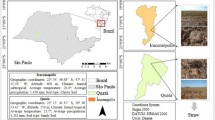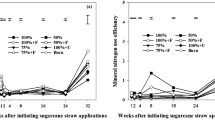Abstract
Sugarcane (Saccharum officinarum L.) straw left in the field after harvest interferes with the growth of winter and summer weeds. In the last years, there was a progressive move away from burning sugarcane straw to retaining it on the soil surface after harvest to prevent soil degradation and environmental pollution. Water-soluble phenolics leachated from straw into soil may suppress weed growth. A study was carried out to investigate (1) the effect of biotic (unautoclaved) soil treated with burned and unburned sugarcane straw leachates on seedling growth and foliar proline content of beggarticks (Bidens subalternans L.) and wild mustard (Brassica campestris L.), (2) the modification of sugarcane straw phytotoxicity in abiotic (autoclaved) soil and biotic (unautoclaved) soil plus activated charcoal, and (3) changes of inorganic ions and phenolic contents in biotic soil after treatment with burned and unburned sugarcane straw leachate. Unburned straw leachate significantly inhibited root elongation of 7-d-old beggarticks and wild mustard seedlings. Burned straw leachate did not affect seedling growth of the assayed weeds suggesting that organic straw phytotoxins were involved. Experiments with activated charcoal, however, did not provide clear evidence supporting the involve of organic molecules in straw phytotoxicity. Unburned straw leachate incorporated in biotic soil was more inhibitory than in abiotic soil on root growth suggesting that microbial activity is involved in sugarcane straw interference. There was no evidence of nutrient microbial immobilization. Unburned sugarcane straw leachate increased total phenolic content in biotic soil more than in abiotic soil or biotic soil plus charcoal. Burned sugarcane straw leachate did not increase phenolic compounds levels in biotic soil. Linear regression analysis indicated a strong correlation between levels of soil phenolic contents and root growth inhibition. Soil characteristics evaluated in soil treated with burned and unburned sugarcane straw leachate suggest that straw phytotoxicity is related with organic molecules, such as phenolic compounds, rather than to variations in inorganic nutrients. Unburned straw leachate induced proline accumulation in seedling leaves of both beggarticks and wild mustard. Proline foliar content was higher in seedlings grown in biotic soil than in seedlings grown in biotic soil plus charcoal suggesting that straw organic constituents induced proline accumulation. Proline foliar content of seedlings grown in biotic soil treated with burned straw leachate was not significantly different from water control. The present study showed that sugarcane straw leachate interferes with seedling growth of beggarticks and wild mustard and that water-soluble phenolics can play a role in the seedling growth inhibition of the assayed weeds.
Similar content being viewed by others
References
S E Allen (1989) Chemical Analysis of Ecological Materials Blackwell Scientific Publishers London
L S Bates R P Waldren I D Teare (1973) ArticleTitleRapid determination of free proline for water stress studies Plant Soil 39 205–207 Occurrence Handle10.1007/BF00018060 Occurrence Handle1:CAS:528:DyaE3sXlsVGitLk%3D
U Blum (1996) ArticleTitleAllelopathic interactions involving phenolic acids J. Nematol. 28 259–267 Occurrence Handle1:CAS:528:DyaK1cXjsVOmsrc%3D
R Boopathy T Beary P J Templet (2001) ArticleTitleMicrobial decomposition of post-harvest sugarcane residue Bioresour. Technol. 79 29–33 Occurrence Handle10.1016/S0960-8524(01)00034-7 Occurrence Handle1:CAS:528:DC%2BD3MXktFeju7g%3D Occurrence Handle11396904
G J Carvalho L A B Andrade M B Gomide P A M Figueiredo (1996) ArticleTitleAllelopathical potentialities of senescent leaves and “green leaves+tips” of sugar cane, in different concentrations of dry matter, upon the germination of lettuce seeds Unimar Ciências 5 19–24
Cheremisinoff P N and Ellerbusch F 1978 Carbon Adsorption Handbook. Ann Arbor Science Publishers.
B R Dalton (1999) The ocurrence and behavior of plant phenolic acids in soil environments and their potential involvement in allelochemical interference interactions: methodological limitations in establishing conclusive proof of allelopathy Inderjit K M M Dakshini C L Foy (Eds) Principles and Practices in Plant Ecology: Allelochemical Interactions CRC Press Boca Raton, Florida 57–74
N T Faithfull (2002) Methods in Agricultural Chemical Analysis: A Practical Handbook CABI Publis New York
B A Hamdi Inderjit M Olofsdotter J C Streibig (2001) ArticleTitleLaboratory bioassay for phytotoxicity: an example from wheat straw Agron. J. 93 43–48
J L Harper (1977) Population Biology of Plants Academic Press London
Inderjit (2001) ArticleTitleSoils: environmental effect on allelochemical activity Agron. J. 93 79–84 Occurrence Handle1:CAS:528:DC%2BD3MXitl2mu7s%3D
Inderjit K M M Dakshini (1999) Bioassays for allelopathy: Interactions of soil organic and inorganic constituents Inderjit K M M Dakshini C L Foy (Eds) Principles and Pratices in Plant Ecology: Allelochemical Interactions CRC Press Boca Raton, Florida 35–44
Inderjit C L Foy (1999) ArticleTitleNature of the interference mechanism of mugwort (Artemisia vulgaris) Weed Technol. 13 176–182
Inderjit J Weiner (2001) ArticleTitlePlant allelochemical interference or soil chemical ecology? Persp Plant Ecol. Evol. Syst. 4 4–12
Inderjit D S Rawat C L Foy (2004) ArticleTitleMultifaceted approach to determine rice straw phytotoxicity Can. J. Bot. 82 168–176 Occurrence Handle10.1139/b03-137
R A Liebl A D Worsham (1983) ArticleTitleInhibition of pitted morningglory (Ipomoea lacunose L.) and certain other weed species by phytotoxic components of wheat (Triticum aestivum L.) straw J. Chem. Ecol. 9 1027–1043 Occurrence Handle10.1007/BF00982209 Occurrence Handle1:CAS:528:DyaL2cXjsFar
Lorenzi H J, Gandini M O, Gazon A L, 1989 Trash blankets: The potential to control weeds and the effect on ratoon cane development. Proceedings of the 20th ISSCT, 571–575
C Manechini (2000) ArticleTitleThe impact of cane trash on weed control Int. Cane Energy News 2 7–9
P Ramos N Pedrol (2001) Free proline quantification M J Reigosa (Eds) Handbook of Plant Ecophysiology Techniques Kluwer academic publishers New York 365–682
Sampietro D A, Vattuone M A, Isla M I, 2005 Plant growth inhibitors isolated from sugarcane (Saccharum officinarum) straw. J. Plant Physiol. (in press)
J Scandaliaris F Pérez Zamora M Rufino E Romero M Morandini (2002) ArticleTitleLa cosecha verde como estrategia para disminuir el impacto ambiental de la caña de azúcar Avance Agroindustrial 1 14–17
S K Schmidt R Ley (1999) Microbial competition and soil structure limit the expression of allelochemicals in nature K M M Inderjit Dakshini C L Foy (Eds) Principles and Practices in Plant Ecology: Allelochemical Interactions CRC Press Boca Raton, Florida 339–352
T Swain W E Hillis (1959) ArticleTitleThe phenolic constituents of Prunus domestica L. – the quantitative analysis of phenolic constituents J. Sci. Food Agric. 10 63–68 Occurrence Handle1:CAS:528:DyaG1MXltFylug%3D%3D
A Walkley I A Black (1934) ArticleTitleAn examination of Degtjareff method for determining soil organic matter and a proposed modification of the chromic acid titration method Soil Sci. 37 29–37 Occurrence Handle1:CAS:528:DyaA2cXitlGmug%3D%3D
T S C Wang J Yang T Chuang (1967) ArticleTitleSoil phenolic acids as plant growth inhibitors Soil Sci. 103 239–246 Occurrence Handle1:CAS:528:DyaF2sXhtFCrsrc%3D
D A Wardle M C Nilsson (1997) ArticleTitleMicrobe–plant competition, allelopathy in arctic plants Oecologia 109 291–293 Occurrence Handle10.1007/s004420050086
Author information
Authors and Affiliations
Corresponding author
Rights and permissions
About this article
Cite this article
Sampietro, D.A., Vattuone, M.A. Nature of the Interference Mechanism of Sugarcane (Saccharum officinarum L.) Straw. Plant Soil 280, 157–169 (2006). https://doi.org/10.1007/s11104-005-2856-5
Received:
Accepted:
Issue Date:
DOI: https://doi.org/10.1007/s11104-005-2856-5




